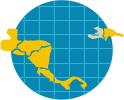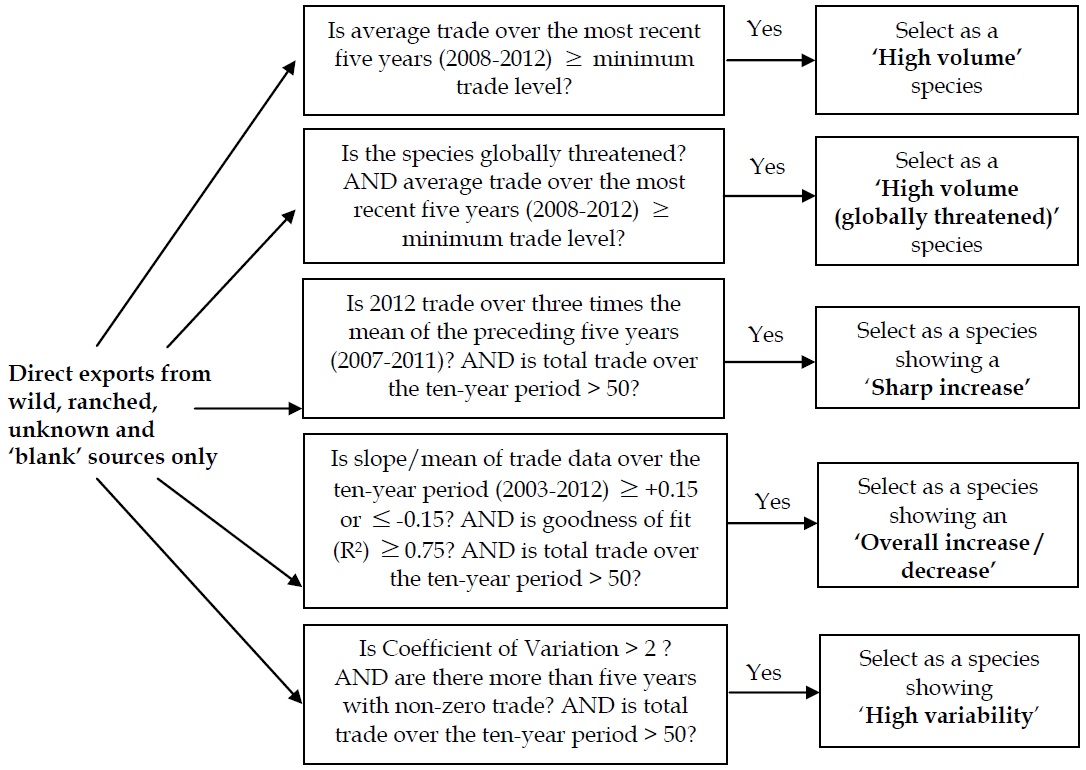Data included
Direct exports from the Region as reported by the exporting countries were used for the selection process. Only trade from wild, ranched and ‘unknown’ sources, as well as trade reported without a source specified, were considered. All taxa, all terms and all purposes (e.g. commercial trade, scientific, etc.) were included in the dataset used for the selection of species.
Selection criteria
The criteria for selection of species showing noteworthy patterns of trade (Chapter II) are summarised in Figure C.1, followed by a detailed description of each criterion. Species were selected if they met at least one of the criteria. Species selected on the basis of trade reported without a source specified that are not known to be native to the exporting country in question were excluded; this was the case for one species (Panthera tigris from Honduras and El Salvador).
High volume
Species qualified for selection on the basis of ‘high volume’ trade if average exports 2008-2012 exceeded pre-determined thresholds based on taxa-wide assumptions of general reproductive biology.
High volume (Globally threatened)
The ‘high volume’ trade thresholds were adjusted for all species categorised as Critically Endangered (‘CR’), Endangered (‘EN’), Vulnerable (‘VU’) or Near Threatened (‘NT’) in the 2013 IUCN Red List of threatened species.
Sharp increase
Species qualified for selection on the basis of a sharp increase in trade if the volume of exports during 2012 was more than three times the average trade volume of the preceding five-year period (2007-2011).
Species that, despite a sharp increase or decrease in trade, were only traded in very low volumes (fewer than 50 units in total over the period 2003-2012), were not selected on the basis of this criterion. Newly-listed species meeting this criterion artificially due to the absence of trade records in previous years were also excluded.
Overall increase or decrease
General trends in trade for each species over the ten-year period 2003-2012 were identified by calculating the slope of a best-fit linear function to the trade data. For the purpose of comparison between species, the value of the slope was divided by the mean level of trade (for the ten-year period in question) for each species. Values greater than +0.15 and lower than –0.15 were considered large slopes. The goodness of fit of the trend-line was also taken into consideration; only species with R2 values greater than 0.75 were retained in the final selection.
As with the sharp increase criterion, species that, despite an overall increase or decrease in trade, were only traded in very low volumes (fewer than 50 units in total over the period 2003-2012), were not selected on the basis of this criterion.
High variability
Variability was quantified using the coefficient of variation (the standard deviation divided by the mean) of the data over the ten-year period 2003-2012. Taxa were selected on the basis of this criterion if levels of trade showed a coefficient of variation higher than +2.
Only species with non-zero data points in more than five years over the period 2003-2012 were considered for selection. In the case of species added to the CITES Appendices within the period of analysis, only the years since its listing were analysed where a minimum of five years of trade data were available. Species that were traded in very low volumes (fewer than 50 units in total over the period 2003-2012) were also excluded.

